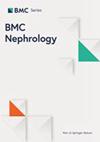Effect of central dialysis fluid delivery system on markers of inflammation in hemodialysis patients
IF 2.2
4区 医学
Q2 UROLOGY & NEPHROLOGY
引用次数: 0
Abstract
The utilization of ultrapure dialysate has been shown to decrease dialysate contamination and mitigate inflammatory responses. The central dialysate delivery system (CDDS) has the potential to attain a level of purity similar to ultrapure dialysate. Nevertheless, there is limited research examining the impact of CDDS on inflammation in comparison to single-patient dialysis fluid delivery system(SPDDS). This study aims to investigate the effects of CDDS utilizing ultrapure dialysate on ameliorating the microinflammatory state in hemodialysis patients. A retrospective cohort clinical study enrolled a total of 125 hemodialysis patients, with 58 patients from the CDDS unit and 67 patients from the SPDDS unit. Each participant was monitored for a period of 6 months, and the repeated measurement data was analyzed using a generalized linear mixed models (GLMM). The average age of the studty cohort was 56.22 ± 12.64 years. The GLMM analysis showed a significant time*group interaction effect on hs-CRP changes over the follow-up period (β = -1.966, FTime* CDDS group = 13.389, P < 0.001). A linear mixed model analysis with random slope showed that a different slope was observed between CDDS group and SPDDS group (βCDDS =—0.793; βSPDDS = 0.791), indicating a decreased hs-CRP levels in CDDS group, while increased in the SPDDS group over the follow-up period. However, no significant time*group interaction effect were observed on albumin and β2-microglobulin levels during follow-up period(β2-microglobulin: β = -0.658, FTime* CDDS group = 1.228, P = 0.269; albumin: β = 0.012, FTime* CDDS group = 1.429, P = 0.233). Using ultrapure dialysate in the CDDS is associated with an improvement in hs-CRP levels compared to standard dialysate, which might confer long-term clinical advantages.中央透析输液系统对血液透析患者炎症指标的影响
事实证明,使用超纯透析液可以减少透析液污染,减轻炎症反应。中央透析液输送系统(CDDS)有可能达到与超纯透析液类似的纯度。然而,与单病种透析液输送系统(SPDDS)相比,有关 CDDS 对炎症影响的研究还很有限。本研究旨在探讨使用超纯透析液的 CDDS 对改善血液透析患者微炎症状态的影响。这项回顾性队列临床研究共招募了 125 名血液透析患者,其中 58 名患者来自 CDDS 单位,67 名患者来自 SPDDS 单位。对每位参与者进行了为期 6 个月的监测,并使用广义线性混合模型(GLMM)对重复测量数据进行了分析。研究队列的平均年龄为 56.22 ± 12.64 岁。GLMM 分析显示,在随访期间,时间*组对 hs-CRP 变化有显著的交互影响(β = -1.966, FTime* CDDS 组 = 13.389, P < 0.001)。随机斜率线性混合模型分析显示,CDDS组与SPDDS组的斜率不同(βCDDS=-0.793;βSPDDS=0.791),表明随访期间CDDS组的hs-CRP水平下降,而SPDDS组上升。然而,在随访期间,白蛋白和β2-微球蛋白水平没有观察到明显的时间*组交互效应(β2-微球蛋白:β = -0.658,FTime* CDDS 组 = 1.228,P = 0.269;白蛋白:β = 0.012,FTime* CDDS 组 = 1.429,P = 0.233)。与标准透析液相比,在 CDDS 中使用超纯透析液可改善 hs-CRP 水平,这可能会带来长期的临床优势。
本文章由计算机程序翻译,如有差异,请以英文原文为准。
求助全文
约1分钟内获得全文
求助全文
来源期刊

BMC Nephrology
UROLOGY & NEPHROLOGY-
CiteScore
4.30
自引率
0.00%
发文量
375
审稿时长
3-8 weeks
期刊介绍:
BMC Nephrology is an open access journal publishing original peer-reviewed research articles in all aspects of the prevention, diagnosis and management of kidney and associated disorders, as well as related molecular genetics, pathophysiology, and epidemiology.
 求助内容:
求助内容: 应助结果提醒方式:
应助结果提醒方式:


